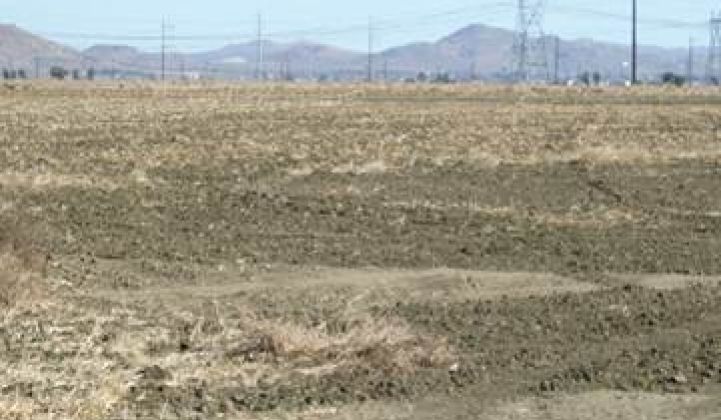The final Environmental Impact Review (EIR) for the Renewable Resources Group's (RRG) 650-megawatt Antelope Valley Solar (AVS) project has been approved.
The project still requires the “various, normal building and construction permits,” RRG Principal Tom Eisenhauer said, but “the final EIR is certified and the conditional use permit (CUP) the project needed was approved by the Kern County Board of Supervisors for the Kern County portions and by the Los Angeles County Regional Planning Commission for the approximately one-fourth of the project in LA County.”
During the approval process, Eisenhauer explained, RRG, a privately held company, worked to make its plans known and to obtain input and guidance from local stakeholders and town councils. "Things like strategies for better local hiring outreach and the importance of wildlife-friendly fencing and complying with ‘dark skies’ principles are a direct result of that outreach,” Eisenhauer said of feedback that followed his January and August 2011 presentations.
AVS, Eisenhauer said, is on track to break ground, as scheduled, in early 2013. “At least six months before then we want to be out in the local community explaining our plans and soliciting more feedback.”
Panel maker SunPower will “oversee” construction, Eisenhauer said. Responsibility for engineering, procurement and construction (EPC) has not been delegated. Completion is projected for 2016. The panels will be installed on single axis trackers that will face the panels directly at the sun as it moves east to west across the desert sky. The SunPower panels have half the reflectance of residential glass and are approved by the U.S. Air Force and the FAA.
_540_449_80.jpg)
AVS will be built on 4,800 acres of previously disturbed private property. RRG’s “light-on-the-land” policy promises the project will have minimal impact on public infrastructure (roads, schools, water lines) and will not affect protected habitat or Significant Ecological Areas (SEAs).The project will conform, Eisenhauer added, to stipulations in the CUP for minimum ground disturbance and for the possibility of complete restoration to agricultural and/or rural residential purposes if/when RRG vacates it. The racks are readily removable and the panels are recyclable.
AVS will span the Antelope Valley Water Bank, an underground water storage facility built by RRG. The solar project, RRG’s first renewable undertaking, will necessitate water use for panel cleaning once or twice a year and for vegetation and dust management. That will, according to RRG, be a fraction of a farm’s water use.
The AVS site is intersected by existing high-voltage transmission infrastructure and by a section of Southern California Edison's Tehachapi Renewable Transmission Project that is now under construction.
AVS’s 36-month construction is expected to provide up to 650 jobs and a windfall of local business activity and revenue. Operations and maintenance will provide 15 permanent, full-time jobs for the life of the project. RRG has repeatedly promised to retain locals as employees, sub-contractors and vendors.
Both CUPs, Eisenhauer noted, require RRG to “maximize [county] sales and use tax revenue” and to use “local addresses in the unincorporated areas of the counties for acquisition, purchasing and billing.”
_540_449_80.jpg)
Like First Solar’s 230-megawatt Antelope Valley Solar Ranch One (AVSR1), now well into construction a few miles away, AVS must next deal with skeptical local residents resistant to an invasion of renewable energy projects that is turning their desert into a renewable energy mecca unlike anything anybody has ever seen.
Communication is problematic in these remote parts of Antelope Valley. Even local newspapers don’t reach residents who, off the grid and beyond efficient cell phone and high-speed internet services, get little notice of events. Many were taken by surprise when the AVS EIR was approved.
A resident whose husband is terminally ill said she is terrified her 40-acre, AVS-adjacent property’s value will deflate before she can sell.
A town council member who met with RRG representatives in the early outreach period said he thought at that time Eisenhauer was “a straight guy,” but, taken by surprise by the EIR’s approval, now suspects RRG of “trying to get under the tent” or “pull a fast one.”
Another town council’s president accused LA County and RRG of inadequate outreach. The draft EIR, he said, was only made public far from the AVS site. RRG held discussions with environmental groups and some local landowners, he acknowledged, but not with the majority of those who live in the project’s vicinity. Notifications were not effectively placed, he said, and the presentations Eisenhauer made to town councils, he added, were less than informative.
Publicly available videos of Eisenhauer’s council presentations contradict the latter point. The rest of the concerns seem designed to drive RRG into the same kind of negotiations with local representatives that, when undertaken by First Solar executives in conjunction with promises of local benefits, brought a tentative resolution to hostilities between AVSR1 and its neighbors.
The hiring process, Eisenhauer said, will include local job fairs announced through the town councils and elsewhere, job ads placed with local press outlets and recruitment efforts at the local community college and local job and training centers.
“We have said publicly and repeatedly that the project is committed to working with the community, supporting local organizations and working with the town councils,” Eisenhauer added, “and engagement will be ongoing.”



